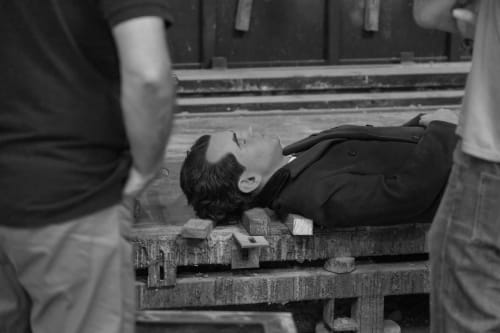The cement that hides the more than 100,000 disappeared by the fascist barbarism.
A counter-monument by artist Eugenio Merino in the form of a public bench highlights the emergency of recovering and vindicating the political commitment of the poet Federico García Lorca, symbol of the more than 100.000 disappeared in Spain.
On Thursday, September 19th; Public bench will open at ADN Galeria (Barcelona), a solo exhibition by artist Eugenio Merino curated by the historian and independent curator Semíramis González. It is included in the programme of Barcelona Gallery Weekend 2024, with the collaboration of Victor Fernández, journalist and expert on the figure of Federico Garcia Lorca, and the participation of the actor and playwright Juan Diego Botto.
The opening will feature the presence of the artist and curator.
Public bench is an investigation into the political ideology of Federico García Lorca, and its instrumentalization from Francoism to democracy, based on the interviews, manifestos and lectures given by the poet during his lifetime and which have been compiled over the years by Ian Gibson, Víctor Fernández and Rafael Inglada.
The result is a sound installation as a memorial, consisting of a cement bench with the sculpture of Federico García Lorca buried inside. It is the same Lorca that could be seen in Madrid, underground and covered with a passable glass, between March and May of this year in the gallery Memoria. This time the monument is buried and hidden in cement, and visitors are invited to sit as Spanish society sits on the crimes of the past.
Public bench seeks to make visible the repression exercised on the thousands disappeared people, as well as to highlight the absence of Lorca’s body and his voice, of which there is no records. The recording heard in the hall is reading of the interviews and conferences that Federico García Lorca gave throughout his life, interpreted by Juan Diego Botto and selected by Victor Fernández from the books Palabra de Lorca: declaraciones y entrevistas completas, De viva voz: conferencias y alocuciones and Manifiestos, adhesiones y homenajes (1916-1936). Merino thus seeks not only to give the poet a physical voice but also to make his ideological position visible to those who deny it. It thus becomes a unique document that recovers Lorca’s political thought linked to the anti-fascist resistance.
“In Public bench we are sitting on all those who disappeared and were murdered in the Coup d’État and the Franco’s repression in Spain, all of them retaliated for their ideas. It is a hidden monument that makes us think about the collective trauma of our history,” says Merino.
The text by curator Semíramis González ends with this question, which is somehow the same question posed by the installation: “Now we remain here and listen to the word of Lorca in his most political texts, his interviews and conferences, through the voice of Juan Diego Botto, now that we are sitting on his image, buried just 20 centimeters from where we are, the reflection of this Public bench becomes more evident: can a society be built on the bodies of those who were repressed and are still under our feet?".
The exhibition will open on 19 September at 12 noon at ADN Galeria (C/ de Mallorca, 205, L'Eixample, 08036 Barcelona), and will remain open to the public until 9 November.
The work of Eugenio Merino explores the narratives of political and economic power and focuses on ideology or the violation of human rights. In recent years he has focused his practice on memory and the visible trace of the dictatorship in contemporary Spanish society.
His work has been exhibited in museums and biennials such as the 15th Biennial of Cuenca (Cuenca, Ecuador, 2021), Museo del Barrio (New York, USA, 2012), Station Museum (Houston, USA, 2015), MOCA (Taipei, Taiwan, 2009), B.P.S.22 (Charleroi, Belgium, 2010), Les Abattoirs (Toulouse, France, 2019), Sculpture Quadrennial Riga (Riga, Latvia, 2012), MAVI (Santiago, Chile 2022) or the Halle 14 (Leipzig, Germany, 2019) among others.
His work can be found in collections such as CA2M Museum (Madrid), Museu de l'Art Prohibit Collection (Barcelona), POC Museum (Brussels), MACAM (Lisbon), olorVISUAL Collection (Barcelona), among others.


